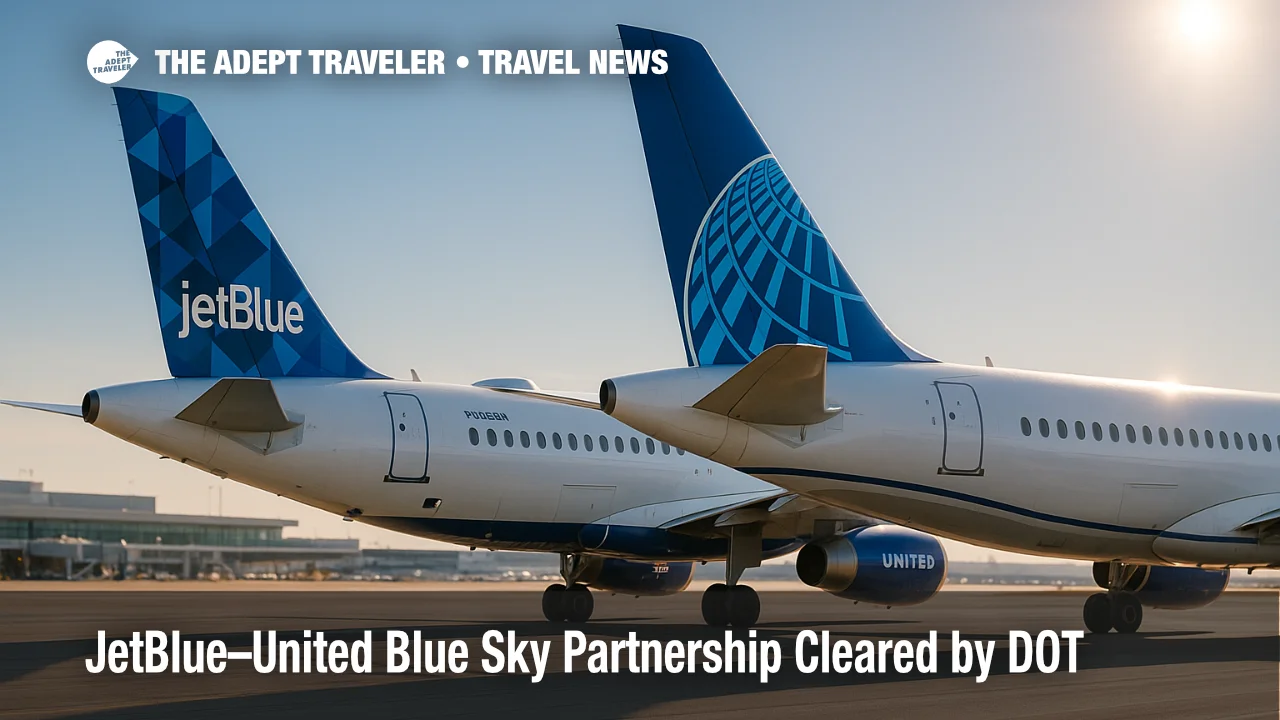JetBlue-United Blue Sky Partnership Cleared by DOT

The United States Department of Transportation (DOT) has approved Blue Sky, a wide-ranging partnership between JetBlue Airways and United Airlines that promises travelers seamless booking, reciprocal loyalty perks, and coordinated schedules at congested New York airports. The carriers said customer-facing benefits will begin rolling out in phases starting fall 2025. The clearance follows a two-month regulatory review and positions both airlines to deepen cooperation while remaining independent competitors.
Key Points
- Why it matters: Blue Sky links two major U.S. carriers, expanding choices for travelers without a full merger.
- Loyalty reciprocity will let MileagePlus and TrueBlue members earn and redeem across nearly 500 combined routes.
- JetBlue will lease United up to seven daily JFK slots starting 2027 and swap eight Newark timings in a net-neutral deal.
- Each airline's website and app will sell the other's flights through an enhanced interline agreement.
- United will migrate its non-air ancillary sales to JetBlue's Paisly platform, modernizing hotels and car-rental packaging.
Snapshot
Blue Sky creates one of the most comprehensive airline collaborations since U.S. antitrust regulators curtailed joint ventures in 2023. Rather than blending fleets or sharing revenue, JetBlue and United will synchronize inventory and loyalty systems while preserving separate corporate identities. The partnership's phased launch starts with reciprocal mileage earning and redemptions, followed by mutual recognition of elite perks such as priority boarding, preferred seats, and same-day changes. Travelers will also gain cross-carrier booking on a single ticket, reducing the need to juggle multiple confirmation numbers. DOT clearance arrived just eight weeks after the airlines announced the plan, underscoring regulatory comfort with its limited scope.
Background
JetBlue has been recalibrating its network strategy since courts blocked its Northeast Alliance with American Airlines in 2023 and its attempted Spirit merger in 2024. United, meanwhile, has sought incremental growth at capacity-restricted JFK while defending its Newark stronghold. Blue Sky allows United to regain a foothold at JFK Terminal 6 using JetBlue's underutilized slots, while JetBlue taps United's global reach for TrueBlue members. Both carriers argue the arrangement will stimulate, not suppress, competition by offering consumers more one-stop options and smoother connections, particularly on the East Coast. Analysts note that DOT, not the Justice Department, led this review, framing Blue Sky primarily as a consumer-benefit question rather than an antitrust test.
Latest Developments
Loyalty Programs Link-Up
When phase one launches in fall 2025, MileagePlus miles will accrue on most JetBlue flights, and TrueBlue points will credit on United's vast domestic and international network. Redemption will mirror each program's existing distance- or fare-based charts, preserving current elite-qualifying metrics. Crucially, elites will receive priority boarding, complimentary preferred or extra-legroom seats, and fee-free standby across both fleets, a first for a non-alliance U.S. tie-up. Industry observers expect a migration of value-oriented flyers toward Blue Sky, especially those based in secondary Northeast markets who previously lacked global earning options.
JFK and Newark Slot Strategy
JetBlue will allocate United up to seven round-trip slot pairs at JFK by 2027, giving United a sustainable presence after it exited the airport in 2015. In exchange, JetBlue receives eight retimed operations at Newark Liberty International, optimizing its banked departures without increasing overall congestion. Both carriers characterize the swap as net-neutral, satisfying DOT's slot-usage and environmental guidelines. Aviation consultants forecast modest fare pressure on transcontinental routes as United re-enters the competitive JFK-LAX and JFK-SFO corridors.
Paisly Powers Ancillary Sales
United will sunset its legacy Vacations engine and adopt JetBlue's Paisly platform to sell hotels, rental cars, cruises, and travel insurance à la carte or bundled with flights. The integration is slated for mid-2026 and is expected to generate an additional $50 million in operating profit beyond earlier projections, according to internal estimates. For JetBlue, licensing Paisly to a network carrier validates its tech investments and opens a new revenue stream unrelated to seat sales.
Analysis
Blue Sky is best viewed as a tactical alliance designed to boost revenue and loyalty stickiness without provoking the antitrust alarm bells that doomed JetBlue's prior deals. By keeping pricing, scheduling, and fleet decisions separate, the carriers avert accusations of coordinated capacity cuts. For United, the partnership restores a gateway to transatlantic business traffic at JFK-critical as corporate travel rebounds-while shoring up Newark efficiency through the slot exchange. JetBlue gains global relevance for TrueBlue and secures a deeper distribution channel via United's website and app.
Regulatory risk remains if rival airlines, notably Delta and American, persuade lawmakers that Blue Sky erodes competition at New York airports. Spirit Airlines has already labeled the pact anticompetitive. However, DOT's swift approval suggests the department views incremental consumer benefits-more one-stop itineraries, improved loyalty value, and tech innovation-as outweighing theoretical harms. The partners must now execute flawlessly: align IT systems, train staff, and communicate changes to millions of loyalty members. Should milestones slip, customer confusion could offset projected gains. Nonetheless, the deal exemplifies airlines' shift toward flexible, tech-centric alliances that expand choice without full mergers, a model likely to proliferate if Blue Sky succeeds.
Final Thoughts
Blue Sky gives JetBlue and United a pragmatic path to grow, modernize ancillary sales, and enhance loyalty without surrendering autonomy. Travelers who prize mileage flexibility, competitive fares, and smooth East Coast connectivity stand to win first. If implementation stays on track, the Blue Sky partnership could redefine how U.S. carriers collaborate in a post-merger, post-alliance era.
